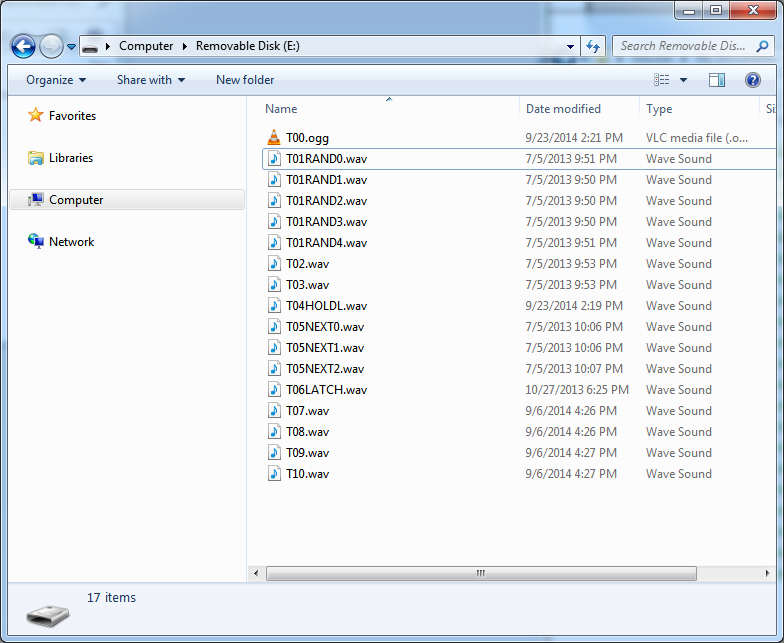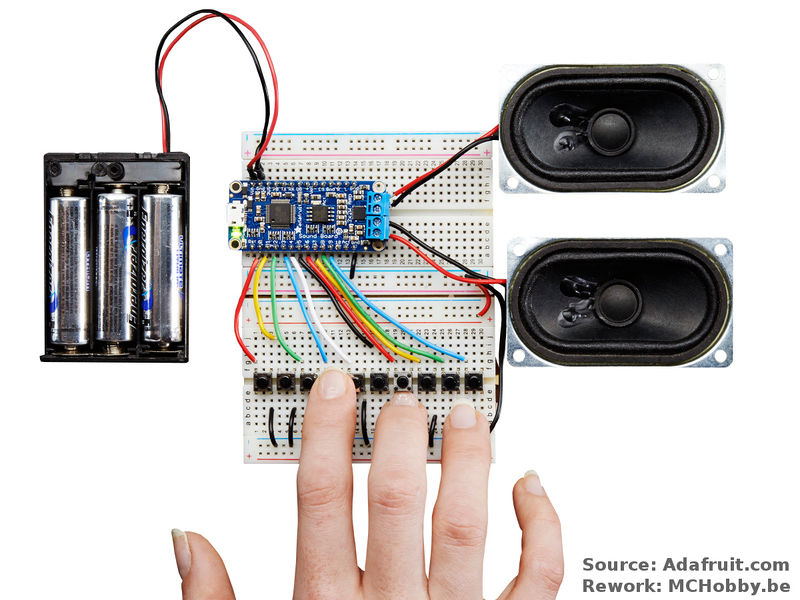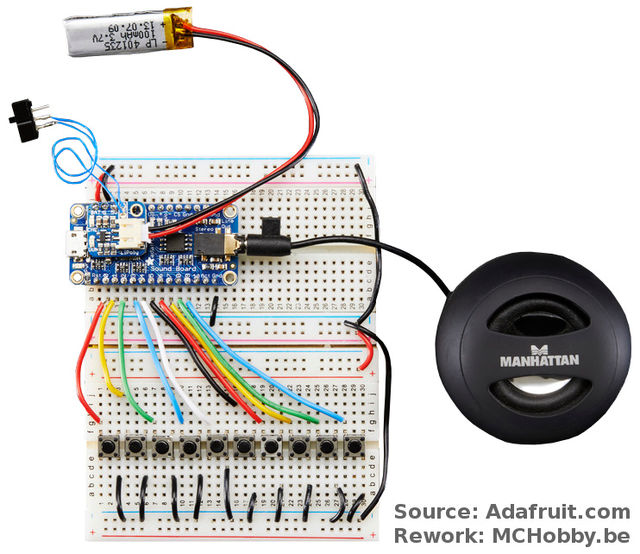ADAFRUIT-AUDIO-FX-trigger
Déclenchement audio
Voila, nous sommes enfin prêt à jouer quelques fichiers audio. Vous pouvez utiliser la carte de deux façons différentes: soit en 'mode déclenchement' (Trigger mode, mode par défaut) ou en 'Mode Série' (destiné à des usages plus avancés, voyez la prochaine page)
Cette page va uniquement se concentrer sur le déclenchement de piste (le mode trigger), c'est ce qui conviendra probablement à la plupart des projets.
Combien de déclencheurs y a t'il?
Il y a 11 broches de déclenchement... 11 trigger pour employer le terme anglais correspondant. Ces broches sont nommées de #0 à #10
Vous n'avez pas besoin de toutes les utiliser! Adafruit disposait simplement de toutes ces broches et les a rendues disponibles :-)
Chacune de ces broches est une entrée que nous recommandons d'utiliser avec un bouton poussoir ou autre type de switch. Lorsque la broche # est connectée sur la masse (GND) environ 50 millisecondes alors elle est déclenchée! Il y a une résistance pull-up de 100K Ohms sur chacune de ces broches (vous n'avez donc pas besoin de résistances ou pull-up supplémentaires).
Rappelez-vous que vous n'avez pas absolument besoin d'utiliser des bouton mécaniques ou interrupteur - vous pouvez également utiliser des fils conducteurs, un contact à bille, deux morceau de papier aluminium, la sortie d'objet électronique... tout ce qui peut renvoyer un signal de masse sur la broche.
Combien de temps faut-il pour commencer la lecture?
Good question! It matters whether you are using WAV or OGG. Compressed audio takes a little more time to get going.
From the moment the SFX board sees a ground level on the pin, it takes ~120ms to play a WAV file and ~200ms to play an OGG file. These are within 'instant feedback' expectation
If 'repeating' a file by keeping the button hend down, or doing a latching trigger type, theres a ~20ms delay (imperceptable) between WAV replays and ~120ms between OGG replays (noticable if the audio is meant to perfectly loop)
Type de déclencheur
There's a lot of different ways you may want to play your sound effects. Normally a microcontroller would be required to get exactly what you want, but the Sound Board is pretty smart and has the ability to play audio a couple different ways depending on the file name.
There's no code or firmware involved, only the file name of the audio file!

Crédit: AdaFruit Industries www.adafruit.com
Let's understand this by going through the five types:
Les déclencheurs ou "effets de déclenchement" ("trigger effects" en anglais) permettent de déterminer la façon dont l'audio est joué. En effet, suivant la nature de votre projet, les fichiers audios devraient êtres joués de tel ou tel façon. Adafruit à identifié 5 besoins différents (les plus communs) qui son inclus dans la carte son. Vous avez juste besoin de renommer votre fichier pour obtenir l'effet désiré.
Déclenchement élémentaire (Basic Trigger)
Tnn.WAV ou Tnn.OGG
The first type is the 'basic trigger' - when the button is pressed, audio plays. The entire file is played from beginning to end once.
To enable this trigger, name the file Tnn.WAV or Tnn.OGG where nn is the trigger #. For example, if you want to use pin #0, the file could be called T00.WAV (that's two zeros after the T), if you want to use pin #6, T06.OGG - all the way up to T11.WAV
Déclenchement avec maintient - en boucle continue (Hold Looping Trigger)
TnnHOLDL.WAV ou TnnHOLD.OGG
This is a more complex trigger. Instead of pressing once the button to play, it plays ONLY when the button is held down. Great for "hold the button down to play the ray gun blaster sound effect" Call the file T02HOLDL.WAV for example
As long as the trigger pin is connected to ground, it will continue to play the same track on repeat. If you want a perfectly smooth transition between the end and beginning, we suggest WAV files, as OGG decompression takes a few milliseconds and has a noticable delay.
Déclenchement on/off - en boucle continue (Latching Loop Trigger)
TnnLATCH.WAV ou TnnLATCH.OGG
This is a little like the Hold Looping trigger but you do not need to keep the button held down. Instead, press the button once to start the looping effect, then press it again to stop.
This is maybe good for if you want a continuous effect without having to keep the pin held down. Call the audio file T08LATCH.OGG for example
If you want a perfectly smooth transition between the end and beginning, we suggest WAV files, as OGG decompression takes a few milliseconds and has a noticable delay.
Déclenchement fichier suivant (Play Next Trigger)
TnnNEXT#.WAV ou TnnNEXT#.OGG
Lets say you want to have one button but many different sound effects. For example, a stuffed animal that has a squeeze sensor trigger. It would say different things each time it is squeezed. For this kind of effect, use the Play Next Trigger.
This trigger is basically like the basic trigger, one button press per play, but you can have multiple effects on one pin
You can have up to 10 audio files triggered on one pin, they will play in order. For example, if you're using pin #3, the files would be named T03NEXT0.WAV, T03NEXT1.WAV, T03NEXT2.OGG etc. up to T03NEXT9.WAV
Just make sure it starts with #0, and put as many as you like up to #9. You do not need to use all 10 '# slots' up. If a number is missing, like T03NEXT3.WAV doesn't exist, it will automatically play #0 again.
Déclenchement aléatoire (Play Random Trigger)
TnnRAND#.WAV ou TnnRAND#.OGG
OK so you like the Play Next mode but you don't want to have it always in the same order? Use Play Random mode. You can have up to 10 audio effects, from say T07RAND0.OGG uo to T07RAND9.OGG
When the button is pressed, a 'random' track will be played.
Please note, this is not 'cryptographic quality' randomness :) In fact, itwill play through all of the tracks at least once (but in any order) before repeating.
Brancher les boutons
If you grabbed the demo tracks from the "how to upload files" page, you can try each of the different kinds of trigger modes
For this demo, I am using a breadboard and small 6mm tactile buttons, but you can use a wire to touch from a trigger pin to GND with headphones plugged into the audio jack
You can see each button connects to the trigger pin, and then the other side to ground. For this demo I'm using the Lipoly backpack but you can power any other way. When buttons are pressed, the audio files on the board get triggered!
Source: Adafruit Audio FX Sound board Crédit: AdaFruit Industries
Créé par Ladyada pour AdaFruit Industries.
Traduit par Meurisse D. pour MCHobby.
Toute référence, mention ou extrait de cette traduction doit être explicitement accompagné du texte suivant : « Traduction par MCHobby (www.MCHobby.be) - Vente de kit et composants » avec un lien vers la source (donc cette page) et ce quelque soit le média utilisé.
L'utilisation commercial de la traduction (texte) et/ou réalisation, même partielle, pourrait être soumis à redevance. Dans tous les cas de figures, vous devez également obtenir l'accord du(des) détenteur initial des droits. Celui de MC Hobby s'arrêtant au travail de traduction proprement dit.
Traduit avec l'autorisation d'AdaFruit Industries - Translated with the permission from Adafruit Industries - www.adafruit.com


